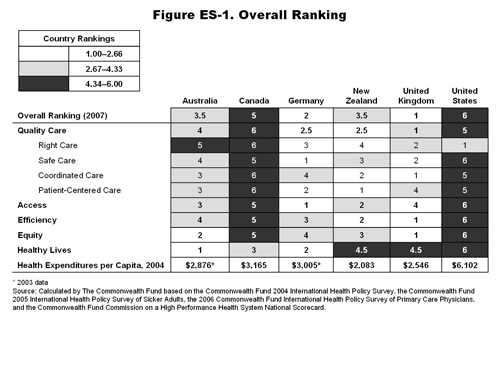See the full series of "Mirror, Mirror" publications, with updated data years.
The U.S. health system is the most expensive in the world, but comparative analyses consistently show the United States underperforms relative to other countries on most dimensions of performance. This report, which includes information from primary care physicians about their medical practices and views of their countries' health systems, confirms the patient survey findings discussed in previous editions of Mirror, Mirror. It also includes information on health care outcomes that were featured in the U.S. health system scorecard issued by the Commonwealth Fund Commission on a High Performance Health System.
Among the six nations studied—Australia, Canada, Germany, New Zealand, the United Kingdom, and the United States—the U.S. ranks last, as it did in the 2006 and 2004 editions of Mirror, Mirror. Most troubling, the U.S. fails to achieve better health outcomes than the other countries, and as shown in the earlier editions, the U.S. is last on dimensions of access, patient safety, efficiency, and equity. The 2007 edition includes data from the six countries and incorporates patients' and physicians' survey results on care experiences and ratings on various dimensions of care.
The most notable way the U.S. differs from other countries is the absence of universal health insurance coverage. Other nations ensure the accessibility of care through universal health insurance systems and through better ties between patients and the physician practices that serve as their long-term "medical home." It is not surprising, therefore, that the U.S. substantially underperforms other countries on measures of access to care and equity in health care between populations with above-average and below average incomes.
With the inclusion of physician survey data in the analysis, it is also apparent that the U.S. is lagging in adoption of information technology and national policies that promote quality improvement. The U.S. can learn from what physicians and patients have to say about practices that can lead to better management of chronic conditions and better coordination of care. Information systems in countries like Germany, New Zealand, and the U.K. enhance the ability of physicians to monitor chronic conditions and medication use. These countries also routinely employ non-physician clinicians such as nurses to assist with managing patients with chronic diseases.
The area where the U.S. health care system performs best is preventive care, an area that has been monitored closely for over a decade by managed care plans. Nonetheless, the U.S. scores particularly poorly on its ability to promote healthy lives, and on the provision of care that is safe and coordinated, as well as accessible, efficient, and equitable.
For all countries, responses indicate room for improvement. Yet, the other five countries spend considerably less on health care per person and as a percent of gross domestic product than does the United States. These findings indicate that, from the perspectives of both physicians and patients, the U.S. health care system could do much better in achieving better value for the nation's substantial investment in health.

Key Findings
Quality: The indicators of quality were grouped into four categories: right (or effective) care, safe care, coordinated care, and patient-centered care. Compared with the other five countries, the U.S. fares best on provision and receipt of preventive care, a dimension of "right care." However, its low scores on chronic care management and safe, coordinated, and patient-centered care pull its overall quality score down. Other countries are further along than the U.S. in using information technology and a team approach to manage chronic conditions and coordinate care. Information systems in countries like Germany, New Zealand, and the U.K. enhance the ability of physicians to identify and monitor patients with chronic conditions. Such systems also make it easy for physicians to print out medication lists, including those prescribed by other physicians. Nurses help patients manage their chronic diseases, with those services financed by governmental programs.
Access: Not surprising—given the absence of universal coverage—people in the U.S. go without needed health care because of cost more often than people do in the other countries. Americans were the most likely to say they had access problems related to cost, but if insured, patients in the U.S. have rapid access to specialized health care services. In other countries, like the U.K and Canada, patients have little to no financial burden, but experience long wait times for such specialized services. The U.S. and Canada rank lowest on the prompt accessibility of appointments with physicians, with patients more likely to report waiting six or more days for an appointment when needing care. Germany scores well on patients' perceptions of access to care on nights and weekends and on the ability of primary care practices to make arrangements for patients to receive care when the office is closed. Overall, Germany ranks first on access.
Efficiency: On indicators of efficiency, the U.S. ranks last among the six countries, with the U.K. and New Zealand ranking first and second, respectively. The U.S. has poor performance on measures of national health expenditures and administrative costs as well as on measures of the use of information technology and multidisciplinary teams. Also, of sicker respondents who visited the emergency room, those in Germany and New Zealand are less likely to have done so for a condition that could have been treated by a regular doctor, had one been available.
Equity: The U.S. ranks a clear last on all measures of equity. Americans with below-average incomes were much more likely than their counterparts in other countries to report not visiting a physician when sick, not getting a recommended test, treatment or follow-up care, not filling a prescription, or not seeing a dentist when needed because of costs. On each of these indicators, more than two-fifths of lower-income adults in the U.S. said they went without needed care because of costs in the past year.
Healthy lives: The U.S. ranks last overall with poor scores on all three indicators of healthy lives. The U.S. and U.K. had much higher death rates in 1998 from conditions amenable to medical care?with rates 25 to 50 percent higher than Canada and Australia. Overall, Australia ranks highest on healthy lives, scoring first or second on all of the indicators.
Summary and Implications
Findings in this report confirm many of the findings from the earlier two editions of Mirror, Mirror. The U.S. ranks last of six nations overall. As in the earlier editions, the U.S. ranks last on indicators of patient safety, efficiency, and equity. New Zealand, Australia, and the U.K. continue to demonstrate superior performance, with Germany joining their ranks of top performers. The U.S. is first on preventive care, and second only to Germany on waiting times for specialist care and non-emergency surgical care, but weak on access to needed services and ability to obtain prompt attention from physicians.
Any attempt to assess the relative performance of countries has inherent limitations. These rankings summarize evidence on measures of high performance based on national mortality data and the perceptions and experiences of patients and physicians. They do not capture important dimensions of effectiveness or efficiency that might be obtained from medical records or administrative data. Patients' and physicians' assessments might be affected by their experiences and expectations, which could differ by country and culture.
The findings indicate room for improvement across all of the countries, especially in the U.S. If the health care system is to perform according to patients' expectations, the nation will need to remove financial barriers to care and improve the delivery of care. Disparities in terms of access to services signal the need to expand insurance to cover the uninsured and to ensure that all Americans have an accessible medical home. The U.S. must also accelerate its efforts to adopt health information technology and ensure an integrated medical record and information system that is accessible to providers and patients.
While many U.S. hospitals and health systems are dedicated to improving the process of care to achieve better safety and quality, the U.S. can also learn from innovations in other countries?including public reporting of quality data, payment systems that reward high-quality care, and a team approach to management of chronic conditions. Based on these patient and physician reports, the U.S. could improve the delivery, coordination, and equity of the health care system by drawing from best practices both within the U.S. and around the world.
